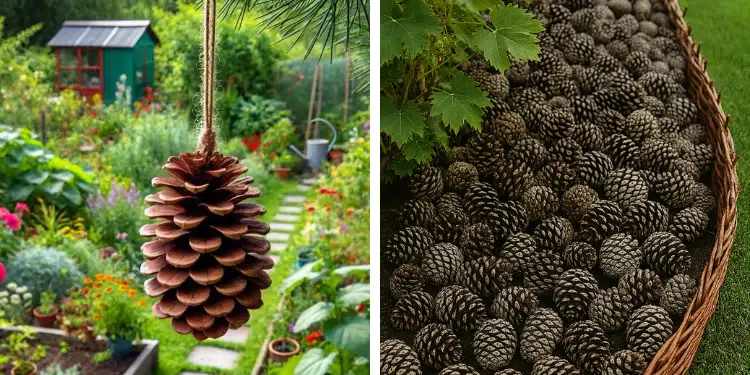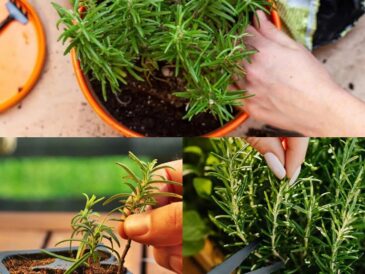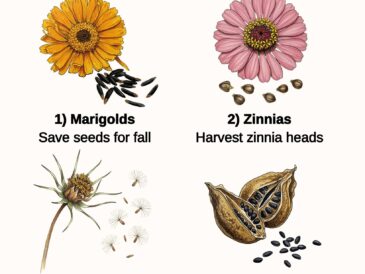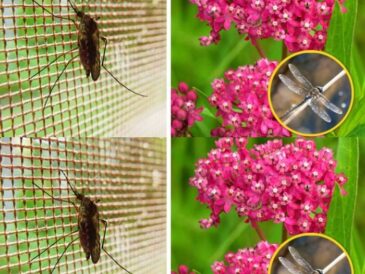Attracting Beneficial Wildlife and Pollinators
While pine cones repel some pests, they attract the “good guys” – pollinators, seed-dispersing birds, and beneficial insects – all of which are crucial to a thriving garden.
1. Feeding Birds in the Fall and Winter
Birds are some of the best natural allies a gardener can have. They eat harmful insects, pollinate flowers, and help spread seeds. But as temperatures drop, food becomes scarce.
A hanging pine cone can double as a natural bird feeder:
How to make it:
- Smear a pine cone with peanut butter or suet.
- Roll it in birdseed.
- Hang it from a tree branch or fence near your garden.
This not only supports bird populations but also keeps insect pests under control naturally.
2. Creating Microhabitats for Beneficial Insects
Pine cones provide tiny crevices that serve as shelter for beneficial insects such as ladybugs, lacewings, and solitary bees – all of which are crucial for pollination and pest control.
How to use:
- Hang a few cones in sheltered spots (like under eaves or tree branches).
- Place clusters in a shallow basket or mesh bag and hang them like an insect hotel.
3. Supporting Pollinator Activity in Early Spring
By attracting birds and insects in fall, you’re essentially setting the stage for better pollination next spring. Many beneficial species overwinter in protected areas and emerge earlier near familiar food sources.
Pine Cones as Natural Soil and Compost Enhancers
Pine cones don’t just belong above ground – they can also be incorporated into the soil ecosystem in surprising ways.
1. Improving Soil Aeration
Crushed or broken pine cones mixed into garden beds improve soil structure, helping air and water penetrate more easily. This is especially useful for heavy clay soils that compact easily in fall and winter rains.
2. Enhancing Compost
While whole pine cones take a long time to decompose, shredded or crushed cones are rich in carbon and can help balance a compost pile.
Their fibrous structure improves airflow, reducing odors and speeding up decomposition.
How to use:
- Break pine cones into small pieces before adding them to compost.
- Mix with “green” materials (like kitchen scraps or grass clippings) to maintain a proper carbon-to-nitrogen ratio.
3. Natural Mulch and Moisture Regulation
Pine cones placed on top of soil act as a light, airy mulch layer. This helps:
- Retain moisture during dry fall spells
- Prevent soil erosion during heavy rain
- Protect root systems from early frost
Over time, they’ll break down slowly, enriching the soil with organic matter.
Decorative and Functional Benefits
Hanging pine cones around your garden isn’t just beneficial – it’s beautiful. They add a rustic, seasonal charm that blends perfectly with autumn colors while still serving a practical purpose.
1. Natural Wind Chimes and Garden Markers
When hung in clusters, pine cones sway gently in the wind, creating subtle sounds and motion. This movement can also deter some flying pests and birds from landing on seedlings.
2. Seasonal Garden Decor with Purpose
Instead of synthetic decorations, pine cones offer a biodegradable, eco-friendly alternative that doubles as wildlife support and natural pest control.
You can even coat them with essential oils (like lavender or peppermint) for additional insect-repelling power.
Cultural and Historical Significance
For centuries, pine cones have symbolized fertility, renewal, and eternal life in cultures from ancient Egypt to Native American tribes.
Many old European gardening traditions recommended hanging pine cones around orchards or vegetable patches in autumn as a charm for good harvests and protection.
While science now explains most of the practical benefits, these age-old customs remind us of the deep connection between nature and gardening – and why such a simple practice still holds meaning today.
How to Collect, Prepare, and Use Pine Cones Properly
To make the most of pine cones in your garden, follow these steps:
Step 1: Collecting Pine Cones
- Best time: Late summer through fall
- Where: Look under conifer trees in parks, forests, or your backyard
- Tip: Choose cones that are fully matured, dry, and intact
Step 2: Cleaning and Drying
- Shake or brush off dirt, insects, and debris.
- Bake in the oven at 200°F (93°C) for 20–30 minutes to kill pests and ensure they’re dry (optional but recommended).
- Let them cool completely before using.
Step 3: Hanging and Placement Tips
- Use twine, jute, or natural fiber string to hang them – avoid synthetic materials.
- Place them near garden entrances, fences, trellises, or around raised beds.
- Hang multiple cones in different locations to maximize benefits.
Creative Ways to Use Pine Cones in Fall Gardening
- Natural humidity sensors: Hang 2–3 around the garden and observe their behavior.
- Companion planting tool: Place pine cones near plants prone to slugs or rodents.
- DIY garden art: Paint or decorate pine cones with natural dyes for functional garden décor.
- Winter prep markers: Use pine cones as indicators of mulching spots or overwintering zones.
Common Myths About Pine Cones in Gardening
Myth 1: Pine cones acidify the soil too much.
→ While fresh pine needles can slightly acidify soil, mature pine cones are mostly neutral and break down slowly without significantly altering pH.
Myth 2: They attract pests.
→ In reality, pine cones deter many garden pests. As long as they’re cleaned and dried, they won’t harbor harmful insects.
Myth 3: They’re just decorative.
→ Far from it. Pine cones play an important ecological role – from weather prediction and pest control to wildlife support and soil improvement.

Hanging a pine cone near your garden might seem like a small, symbolic act – but its impact is surprisingly powerful.




